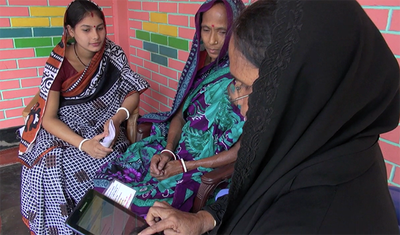Sounds like Digital Innovation
By Kimberly Best
DHAKA, Bangladesh—You’d think that on the roof of a six-story hotel located in a “quiet” district of town, street sounds would be somewhat muffled. Not so in Dhaka, Bangladesh. Below me, a jackhammer sounded off. Another joined it, amidst a staccato honking of horns and long blares. For a second, the honks at various frequencies sweetly intertwined with the quaint trills of bicycle and rickshaw bells. Then they were gone: muted by the sounds of scraping shovels, screeching saws, clanging metal and whirring cement mixers from a construction site nearby.
This matters to me because I’m a videographer. And not a single piece of my footage in Dhaka is free of ambient noise.
Even a bucolic river scene was covered with a heavy lid of rowdy sound. The relentless, immediate noise found throughout Dhaka was superimposed on layers of dissonant sound, at the bottom of which was a dull background of hum and hiss. This is the soundscape of a capital city in a country fiercely determined to progress rapidly. Last July, Bangladesh proudly embraced its promotion from “low-income” designation by the World Bank to “lower middle-income.” It aspires to reach “middle” income status by 2021, its 50th birthday and also to become a “digital Bangladesh” by that time.
My shoot was set in Dhaka, where I stood on that roof, and in Tangail district – a restful, rural area about three hours northwest. I planned to interview health ministry officials in town and to film the process of gathering population data in Tangail. There, health workers go door to door with digital tablets, revolutionizing their own work to gather population data. Eventually they will also collect health data so their country can achieve better health programming.
Because “clean” audio is essential to my interviews, I sought refuge from the noise, sometimes through unusual effort, deep within a building, searching for quiet spaces. Often, I traded noise outside for a tiny, tucked-away room with little natural light but dizzying, strobing fluorescent lights. Even in this setting, a jackhammer or two would often erupt outside, shattering the calm. I was impressed by the Bangladeshis with whom I worked who, accustomed to enduring stoically the traffic of Dhaka, were also remarkably patient during the long, tedious process of repeating “takes” until I could get the clean sound bite I needed.
Interviews done, I needed to venture out in Dhaka for essential b-roll, to set the scene. Due to concerns associated with recent attacks by radical Islamists, U.S. citizens were warned to stay inside their hotels and/or workplaces. How is a videographer supposed to film a place without access to its public areas? Here’s how: I sat on the windowsill of my hotel room, filming street scenes from above and panning across the city. I ventured to the roof of another, much taller building, stepping over cement, cables, small dividers and barricades to get an aerial view of a mosque and the sound of its call to prayer.
 Finally, I risked an hour out on the streets. I am small, and so is my video camera. When crouching, I am barely the size of a piece of carry-on luggage. But as soon as one of the many men on the street would see me, the heads began to pivot in my direction. They looked and stared. Transfixed. Their stares were steady and unblinking. Prolonged staring is a cultural norm among men here. But the serious expressions did not particularly communicate welcome.
Finally, I risked an hour out on the streets. I am small, and so is my video camera. When crouching, I am barely the size of a piece of carry-on luggage. But as soon as one of the many men on the street would see me, the heads began to pivot in my direction. They looked and stared. Transfixed. Their stares were steady and unblinking. Prolonged staring is a cultural norm among men here. But the serious expressions did not particularly communicate welcome.
In fact, Bangladesh was a strange mirror image of my usual assumptions about where I am welcome – as a woman, as a U.S. citizen and as a videographer. I generally would feel welcome on a public street. Not here. Conversely, I generally do not feel welcome, or free to film, in private areas, such as clinics where people receive medical care. But, in Bangladesh, I was permitted to move anywhere in clinics, filming intimate scenes. A mother cradling her limp child, who was being treated for acute dehydration due to diarrheal disease. Couples receiving counseling. Adolescents holding their sick siblings. My own sense of propriety was the only reliable filter I had for filming in such settings.
Birds chirping, cats mewing and children calling to each other replaced honking horns. The standard welcome – small talk and refreshments often offered before interviews began – was warmer, more relaxed. And filming in these naturally-lit rural settings was a visual gift. One Hindu home was a rainbow of colors – pink, turquoise, purple, red, green, blue and yellow – with a geometric pop of diamond-shaped trim.
It’s possible that some people we filmed in Tangail had never seen a video camera before. Yet all of them had the good grace to play along with the re-enactments we devised: A woman swept the floor of her home with a straw broom. Another carefully braided her daughter’s hair. Others cooked lunch in a pot under a small umbrella.
But perhaps my favorite shot was an unscripted one. In Tangail, among a sizable group of children, a very young boy stood out. He stared at the camera, unblinking, stern and steady, practicing what it might look like – one day – to be a man in Bangladesh.
Reprinted with permission from the University Gazette on May 25, 2016.













